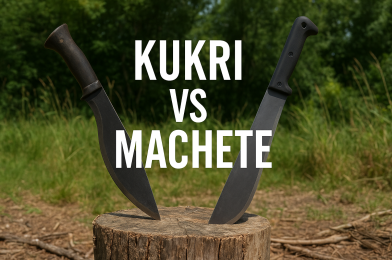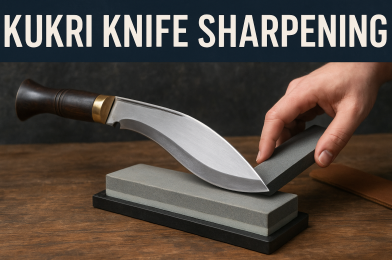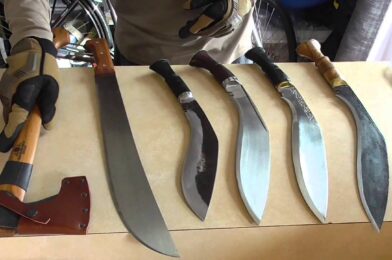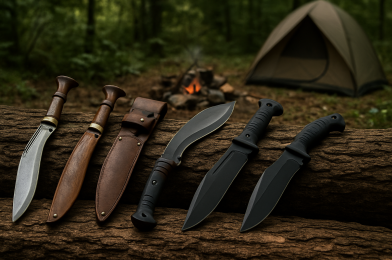Kukri vs machete is a classic outdoors showdown. Both are big knives that can clear brush or chop wood, but they have very different designs and uses. A machete is a long, straight, broad blade (often 12–26 inches long) used like a large knife or light axe for clearing vegetation. In many tropical countries, farmers swing machetes to cut through sugarcane, vines and tall grass. A kukri is a shorter (16–18 inch) curved blade from Nepal, famous as the Gurkha soldiers’ knife. It has a pronounced recurve (bent blade) that makes it act like an axe at the tip. We’ll explain how these two blades compare, highlight their pros and cons, and provide reviews of the best picks. By the end, you’ll know which tool suits your needs (and where to buy it).
What Is a Machete?
A machete stuck in a tree stump. Machetes are long, broad blades perfect for chopping through brush and cutting wood. A machete is a broad, hand-held knife up to 30–66 cm (12–26 in) long. It’s often used in farming and yard work. For example, machetes allow you to easily slice through tall grass, vines, and sugarcane (as seen when farmers use them to cut cane). Because the blade is long and relatively thin (under 3 mm thick), a machete can swing fast and reach far – handy for clearing a trail without moving your feet. Most machetes have a simple handle (plastic or wood) and a full-tang carbon steel blade. Many are very affordable (basic models under $30 can do the job). Pros: You get a cheap, lightweight tool with a lot of reach. Cons: the thin blade isn’t for heavy chopping – it can bend if you hit a hard knot or log. Also, the edge can dull if you twist the blade.
Farm workers cutting tall sugarcane using machetes. The machete’s long blade and lightweight let them slice through vegetation all day. In warm climates, machetes are a go-to tool for farmers and gardeners. Their long, straight blades are excellent at sweeping through weeds, underbrush, and light wood. A beginner or child (with supervision) could start with a smaller machete or even a toy training blade to learn. Wear gloves and swing carefully, because a machete can cause serious cuts. After clearing, just sheathe it or lay it flat on the ground – the blade length gives good reach for each chop, but remember to keep bystanders at least an arm’s length away. Machetes are tools of the people: cheap models exist (some experts say anything over $30 is “overkill”), and they require little maintenance other than a quick sharpening when needed.
What Is a Kukri?
A kukri (or khukuri) is a heavy Nepalese knife with a distinct bent blade. Unlike the machete’s straight edge, the kukri’s blade curves inward and then flares out near the tip. This shape concentrates weight at the end of the blade, so it chops powerfully like a small axe. A typical kukri is about 40–45 cm (16–18 in) long and weighs 450–900 g (1–2 lb) – shorter but heavier than a machete. The kukri is the national weapon of Nepal and the Gurkha warriors’ utility knife. Gurkhas still carry one as their standard issue: a large ceremonial kukri and a smaller exercise kukri.
A kukri serves many roles. In Nepal, it is a farm and survival tool as much as a weapon. Farmers use kukris to cut crops, clear brush, and even chop small logs. Hunters use it for skinning game. It can double as a cooking or woodworking tool. For example, one use of the kukri is that the heavy blade easily splits logs or chops rope – tasks that would be hard for a long machete blade. Pros: excellent chopping power in a small package. Kukris are usually made of thick, high-carbon steel (often 1075 steel or better) with durable handles, so they last through hard use. Cons: The blade is short, so you lose some reach compared to a machete. The extra weight makes it tiring for long, sweeping cuts. Also, the curved blade can be trickier to sharpen at home.
Kukri vs Machete: Side-by-Side Comparison
| Feature | Kukri | Machete |
|---|---|---|
| Blade Length | ~40–45 cm (16–18 in) | ~30–66 cm (12–26 in) |
| Blade Shape | Pronounced recurve (bent inward) | Mostly straight or slight curve |
| Weight | 450–900 g (1–2 lb) | ~300–500 g (0.5–1 lb) |
| Uses | Chopping wood, digging, multi-task tool | Clearing brush, farming, yard work |
| Material | Thick high-carbon steel (robust, holds edge) | Carbon or stainless steel (lighter but can flex) |
| Advantages | Axe-like power and chopping ability; durable (military-tested) | Longer reach, lighter to swing, and very affordable |
| Drawbacks | Shorter reach; heavy (can tire you); usually pricier | Less chopping force; thin blade may bend; edge needs frequent sharpening |
In practice, machetes excel at sweeping, lighter cuts and keep you farther from whatever you’re cutting. They are great for open brush, vines, crops, and day-long yard work. Kukris excel at focused chops and heavy tasks – think driving through a thick branch or splitting kindling. The kukri’s inward curve means it “self-feeds” into wood on a chop, whereas a machete relies on momentum from its length.
Pros and Cons
Machete – Pros
- Long reach lets you clear a wide swath in each swing.
- Very affordable and easy to find.
- Lighter weight means less fatigue for beginners.
- It’s also flexible, so it won’t snap if you hit a rock (though it might bend).
- Many users praise budget machetes as great value.
Machete – Cons
- Not great for hacking thick logs or chopping hard wood.
- The long, thin blade can buckle under heavy force.
- You also lose precision – it’s harder to do fine cutting or stabbing.
- Under heavy use it needs frequent sharpening.
Kukri – Pros
- Huge chopping power in each swing, almost like a hatchet.
- The thick blade holds an edge well, so it stays sharp longer and can drive through small branches easily.
- Versatile for survival – you can use it as a foot-long knife, axe or even a crude shovel.
- Many users admire its balance and toughness.
Kukri – Cons
- Quite heavy, so it can wear out your arm faster.
- Shorter blade means less reach – you may need to step closer to cut effectively.
- More expensive and harder to find than a simple machete.
- The curved blade also makes techniques like fine cutting or stabbing a bit harder for beginners.
Common Pitfalls to Avoid
When shopping or using these blades, watch out for common mistakes:
- Cheap, Shoddy Blades: Extremely cheap machetes (under $10) often have flimsy handles or poor steel that rusts quickly. Avoid handles that flex or heads that wobble. Look for full-tang blades (steel running through the handle) for strength.
- No Sheath: Never buy a big knife without a proper sheath. A good leather or Kydex sheath protects you and the blade. Without it, a slip can cause serious injury or dull the blade.
- Ignoring Maintenance: Both kukris and machetes need sharpening and oiling. Don’t leave them wet or dirty. A rusty blade is much weaker.
- Wrong Tool for the Job: Don’t try to use a machete like a pry bar or hammer, or a kukri to cut grocery items. Use them for plants, wood, or camping tasks as intended.
- Overconfidence: Beginners sometimes swing hard without clearing the area. Always ensure a safe swing zone. Keep others (especially kids) at a distance. A mistake can be dangerous with these sharp blades.
- Kid Safety: Kids shouldn’t use a real machete or kukri unsupervised. If youngsters want to help, start with plastic “practice” machetes or very short blades under close watch, and teach blade safety first.
Buying Guide: How to Choose
Here are key factors to consider before buying:
- Blade Material: Carbon steel (like 1055, 1075, O1) is common and holds an edge well, but it can rust if not oiled. Stainless steel resists rust but may not hold a sharp edge as long. For outdoor work, many prefer carbon steel for toughness. (For example, the Condor Kukris use 1075 carbon steel.)
- Blade Length & Weight: Decide how much reach you need. A longer machete (20–24 inches) lets you cut farther but is heavier. A kukri’s curved blade naturally gives more power in a shorter length. If you want a lightweight tool for easy handling, a small machete is best. For heavy chopping, a heftier kukri or “bolo” style machete might suit you.
- Handle & Tang: Full-tang means the blade’s metal extends through the handle – this is strongest. Handles can be wood, micarta, rubber, or plastic. Wood (like walnut) looks nice; micarta or rubber gives a sure grip even when wet. Test that the handle feels comfortable in your hand and isn’t too slippery.
- Safety Features: Many kukris and machetes have a built-in finger guard (cho or karda in Nepalese knives) to stop your hand from sliding onto the blade. This is helpful. Also check for a good sheath – nylon, leather or Kydex. If safety lock on the sheath is solid, the blade won’t fall out.
- Ease of Use: If you’re a beginner or older, lean toward lighter, simpler blades. A 12-inch kukri might be easier to swing than a 15-inch one. For kids or teens, consider shorter blades and always supervise.
- Durability: Read reviews to see if a blade stays sharp or if the tip snaps. Look for knives with heat-treated steel (many will list Rockwell hardness). Reviews often note if a machete arrived dull or rusted – avoid those brands.
- Budget: Prices for quality machetes range from $20 to $100. Kukris tend to start around $70 and go up. Remember, you often get what you pay for: a $15 machete might serve for light yard work, but won’t compare to a $100 Condor or Cold Steel product in toughness.
Where to Buy
These blades are available on Amazon (with our affiliate links below). You can also sometimes find deals on eBay, Walmart, or specialty sites. Just be cautious of very cheap knock-offs. A reliable vendor (or a site like Amazon with return policies) is safer.
Best Machete Picks
Here are some top-rated machetes available now. All are in stock on Amazon. Click the links to check current prices (with affiliate tags included). You may also find similar listings on eBay or other sites.
-
Ontario Knife Company 18″ Military Machete (Model 8280) – This U.S.-made machete is a classic. It has an 18-inch 1095 carbon steel blade (full tang) and a tough polymer handle. It’s very durable for chopping wood or brush. Pros: Extremely strong blade; excellent for heavy-duty chopping. Cons: The handle is hard plastic (not as comfy as rubber); there’s no finger guard. Overall weight is on the heavier side. Check price on Amazon or look for deals on eBay.
-
Tramontina 24″ Machete (Brazilian Carbon Steel) – A longer blade (24 inches) for maximum reach. This well-known Brazilian brand is affordable (~\$20). It has a slim, high-carbon blade and a simple handle. Pros: Very lightweight for its length; great for clearing tall grasses. Cons: Blade is relatively thin (can flex if you hit something hard); handle is basic. For about \$20, it’s an excellent yard-tool choice. Check price on Amazon or search eBay.
-
Condor El Salvador Machete (18″, 1075 Carbon Steel) – A premium machete popular among survivalists. It has an 18-inch blade of high-carbon 1075 steel (coated to resist rust) and a comfortable polypropylene handle. Comes with a thick leather sheath. Pros: Very tough and sturdy (the 1075 steel stays sharp longer). Solid balance and build. Cons: Heavier than cheaper machetes; costs more (~\$75). Ideal if you want a tool that can double as a survival knife. Buy on Amazon or check for it on other marketplaces.
Best Kukri Picks
For those looking for kukris, here are highly rated options:
-
Condor Heavy Duty Kukri (9″ Blade) – A well-reviewed, classic-style kukri. It has a 9-inch 1075 carbon steel blade and a walnut wood handle with a leather belt sheath. Pros: Full tang and very sturdy (used by experts and even TV survival contestants). Good weight and balance for chopping. Cons: At 9″ blade, it’s on the smaller side for very heavy tasks; average blade (not as long as military kukris). Check price on Amazon.
-
Condor K-Tact Kukri (10″ Blade) – A modern take on the kukri. It has a 10-inch, 6mm-thick high-carbon steel blade and a green micarta handle. Comes with a rugged Kydex/leather sheath. Pros: Super tough blade (heavy-duty 6mm thickness). Comfortably balanced for serious chopping. Cons: At around \$140, it’s pricey. The large blade and handle make it heavy for finer tasks. Check price on Amazon.
-
KA-BAR 11.5″ Kukri (Ka-Bar 2-1249-9) – A renowned American-made design. The 11.5-inch blade is very heavy (over 2 lbs total) with a steel pommel for full balance. Pros: Authentic Gurkha style; extremely durable 1095 carbon steel. Many users praise its power and history. Cons: Very heavy; the handle has a simple finger ring (no full guard). If you want a piece of history, it’s a great pick. Check price on Amazon (note: often sold out, so check eBay as well).
Each of these products has customer reviews confirming their quality (3–4 star ratings on Amazon). They span from beginner-friendly (Tramontina machete) to top-end (Condor and KA-BAR). Evaluate your budget and intended use when choosing. Also, note that many of these tools are listed on eBay or similar for those looking for alternative sellers or second-hand options.
Safety Tips
Using large knives safely is critical:
- Proper Grip & Posture: Always hold the handle firmly and stand in a stable stance. Swing or chop away from your body. For machetes, use wide sweeps; for kukris, a downward thrust-and-chop motion often works best.
- Protective Gear: Wear thick gloves and safety glasses when you practice. A slash guard (a simple sheath that prevents hand overrun) is great if you’re a beginner.
- Clear Work Area: Make sure nobody is close by when you swing. Even if you slip, the blade should hit wood or dirt – not a person.
- Check the Blade: Before each use, ensure the blade is sharp and free of cracks. A dull or damaged blade can slip off wood unexpectedly. Keep your blade dry and clean to prevent rust and loss of structural strength.
- Knife Laws: In the USA, laws vary. Generally, a non-locking blade over 2.5 inches is subject to some local restrictions. A machete is usually legal for outdoor work, but always check state and local rules for carrying large knives in public.
- Kids and Beginners: Never let children use a real machete or kukri unsupervised. For teen or beginner projects, use smaller blades under adult guidance. A good rule: if a child can’t control a sharp kitchen knife safely, they shouldn’t use these big knives yet.
Conclusion
Both machetes and kukris are valuable outdoor tools with their own strengths. If you need a long reach and fast clearance (for gardening, trail-blazing or farming), a machete is usually the better pick – it’s lightweight and easy to swing. If you need powerful chopping ability (for wood processing, survival tasks or self-defense), the kukri’s heavy, curved blade is hard to beat. Think about where and how you’ll use your blade: clearing bushes vs. splitting logs vs. survival camping.
We’ve listed top products above to fit different needs and budgets. Each link goes to Amazon (affiliate tag included) where you can buy or find more info. Many of these items or similar ones also pop up on eBay or other stores if you want to compare prices.
Stay safe, pick the right blade for the job, and happy chopping!
Sources
Authoritative descriptions and comparisons of machetes and kukris (Wikipedia and expert gear reviews) were used to gather facts about design, uses, pros and cons. This includes the blades’ sizes, origins, typical uses, and material construction. The Prepared’s gear guide provided details on blade differences and recommendations. These sources ensure accurate, up-to-date information for our guide.




